Coniferous Tree Catalog
Contact the office for a current pricelist
Sales open in January and run through March
The tree supply is limited and conifers sell out fast, so make sure to purchase early
Coniferous trees and shrubs that produce cones and typically have needle-like or scale-like leaves, often remaining green year-round (evergreen). It refers to plants belonging to the group known as conifers. Sometimes called evergreens, most coniferous trees keep their foliage year-round. There are over 600 living species of conifers, and while there is some debate over how many are native to Canada, the number is approximately 30. Conifers include the oldest and tallest trees. The oldest, the Bristlecone pine, can live to be nearly 5,000 years old. The tallest, the Coast redwood, grows to over 100 m high. Both of these conifers grow in California. Products made from coniferous trees include paper, many kinds of lumber, furniture and anti-cancer drugs. In large part because of their usefulness, conifers are in danger. Exploitation, forest degradation and habitat destruction have placed 34 per cent of conifers under threat of extinction. They are often used as windbreaks due to their hardy natural and dense branches.
Austrian Pine
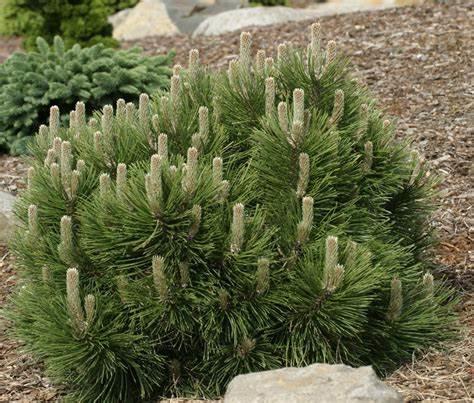
PINUS NIGRA
- Leaves & Flowers
Features dark green needles grown in bundles of two that sometimes curve or twist slightly; they are 3–6" long and persist for 4–8 years, giving the tree its dense crown. The tree grows in an oval shape.
- Fruits:
Produces somewhat oval, light brown cones that are 2–4" in length; each scale is tipped with a small prickle
Is also known as the European black pine
- Growth Habit & Hardiness
The Austrian Pine is very hardy and works well for windbreaks. It tolerates adverse soil conditions and air pollution. Since it was introduced to the U.S. in 1759, this pine has been put to work as both a beautiful landscape tree—with its dense, dark green crown—and a working tree that restores strip mines and scarred land, stabilizes soil and tames the wind. Mature Height can be 50' - 60' and mature spread can be 20' - 40'.
- Fall Color:
It will retain its needles and color throughout the winter months.
- Wildlife Value:
Birds and squirrels enjoy Austrian pine seeds. The large evergreens also provide shelter and nesting sites, particularly for birds such as owls.
Black Hills Spruce
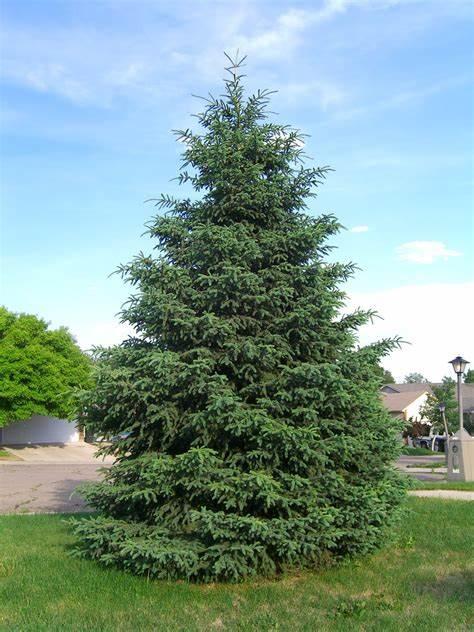
PICEA GLAUCA
- Leaves & Flowers
It has bright green needles. It works well as an ornamental or in windbreaks and screens and offers a denser, more compact habit than the white spruce.
- Fruits:
It produces numerous small pine cones.
- Growth Habit & Hardiness
The Black Hills spruce is a variety of the more widespread white spruce found naturally only in southwest South Dakota and a small portion of northeast Wyoming. While not as widely known as other spruces, this ornamental spruce can be planted just about anywhere that the more common Colorado spruce will grow.
Is adapted to cold, is very resistant to winter injury and requires little pruning. The Black Hills Spruce grows slowly. Its mature height can be 30' - 60' and its mature spread can be 15' - 25'.
- Fall Color:
It will retain its bright green needles and color throughout the winter months.
- Wildlife Value:
The Black Hills spruce provides nesting sites for birds and makes a good winter cover. The seeds provide food for songbirds, upland ground birds and small mammals. The bark serves as food for porcupines, and the foliage is lightly browsed by deer.
Colorado Blue Spruce
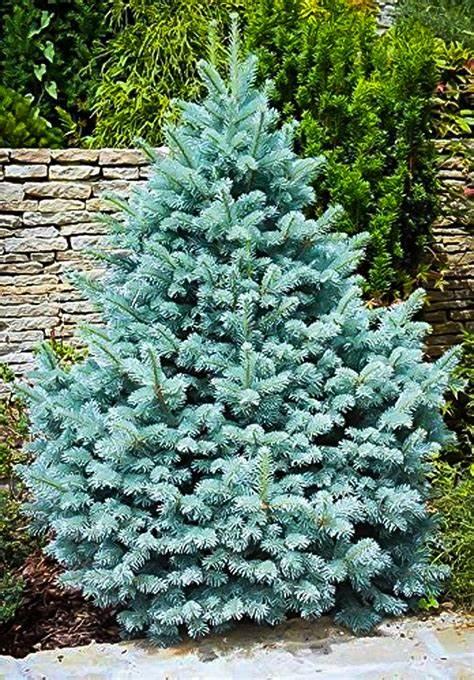
PICEA PUNGENS
- Leaves & Flowers
This tree features unique silvery blue-green color to its needles. Its growth is slow to medium. One of the most popular ornamental conifers, the Colorado blue spruce is a truly magnificent sight. Its silvery blue-green coloring and perfect Christmas tree shape make this tree a great landscaping focal point on commercial and residential properties.
- Fruits:
This tree produces long, narrow pine cones.
- Growth Habit & Hardiness
It is also widely used for privacy or a windbreak. Known as a very adaptable evergreen as it is deer-resistant, seldom experiences severe damage and provides privacy and a windbreak when planted in a row. Its mature height is 50' - 75' and its mature spread is 10' - 20'.
- Fall Color:
It will retain its blue color throughout the winter months.
- Wildlife Value:
This spruce provides food and shelter for siskins, nuthatches and crossbills.
Douglas Fir
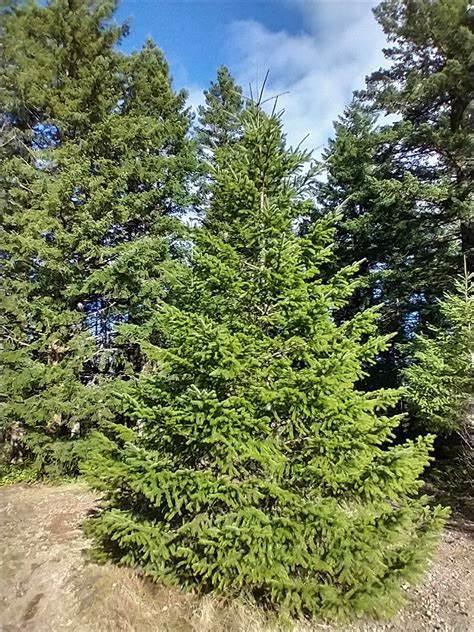
PSEUDOTSUGA MENSIESII
- Leaves & Flowers
Displays bluish-green needles and its attractive appearance and growth rate make it popular in yards and parks.
- Fruits:
This tree produces small oval shaped pine cones.
- Growth Habit & Hardiness
Douglas fir is one of the nation’s most important lumber species, it makes up nearly half of all Christmas trees grown in the U.S. It provides good windbreak and can be used as a living snow fence. Is naturally deer-resistant. It has a medium growth rate with a mature height of 40' -70' and a mature spread of 12' - 20;.
- Fall Color:
It will retain its bluish color throughout the winter months.
- Wildlife Value:
Douglas Fir seeds are used by blue grouse, songbirds, squirrels, rabbits and other small animals. Antelope, deer, elk, mountain goats and mountain sheep eat the twigs and foliage. It provides excellent cover for a wide range of animals.
Eastern Redcedar
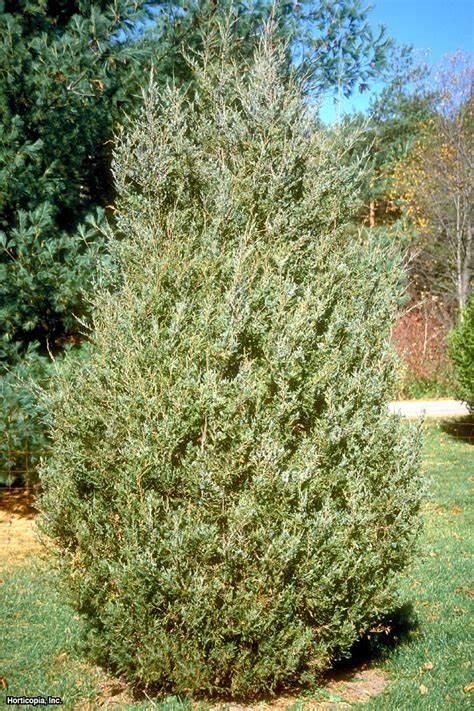
JUNIPERUS VIRGINIANA
- Leaves & Flowers
The eastern redcedar tree is a common sight throughout most of the plains states and eastern United States on road cuts, in fence rows, and scattered across abandoned fields — especially where limestone soils are present.
- Fruits:
This tree produces small berries that attract birds.
- Growth Habit & Hardiness
Thanks to its tolerance of heat, salt, a wide range of soils and other adverse conditions, this evergreen can be put to good use on the farm in windbreaks and in city landscapes for hedges, screens, clumps, or even as specimen trees. Tolerates heat, wind, and salt, develops deep roots and works well for windbreaks and screens. It has a medium growth rate with a mature height of 40' -50' and a mature spread of 8' - 20'.
- Fall Color:
It develops a deep rust color throughout the winter months.
- Wildlife Value:
Eastern redcedar twigs and foliage are eaten by browsers while the fruit is eaten most extensively by cedar waxwings. Evergreen foliage provides nesting and roosting cover for sparrows, robins, mockingbirds, juncos and warblers.
Meyer Spruce
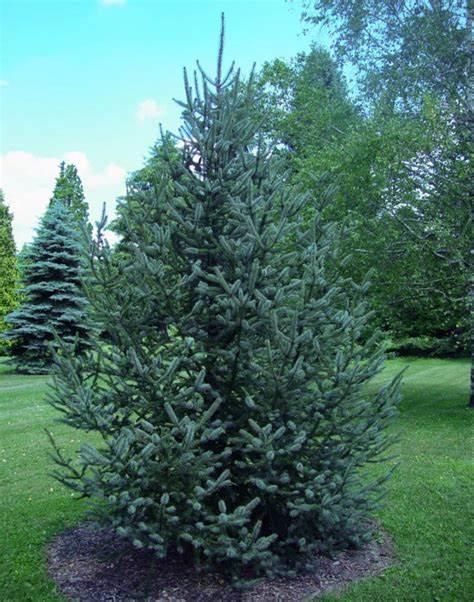
PICEA MEYERI
- Leaves & Flowers
The Meyer’s spruce has an attractive blue-green hue with a dense pyramidal habit and short needles and a dense form. It has long thin needle spires at the end of its branches.
- Fruits:
No pine cones
- Growth Habit & Hardiness
This evergreen does well in urban conditions and is more disease-resistant than the Colorado blue spruce it is often compared to. It tolerates drought and is deer-resistant. It matures slowly to a height of 40' and a spread of 10' - 20'.
- Fall Color:
It produces short blue-green needles that lasts throughout the winter months.
- Wildlife Value:
Meyer Spruce trees are not particularly known for attracting a wide range of wildlife, but they do offer some benefits. They provide shelter and some food for birds and small mammals, particularly during the winter months. While not a major food source, their needles and seeds can offer sustenance to certain species, and their dense branches offer protection from the elements and predators
Ponderosa Pine
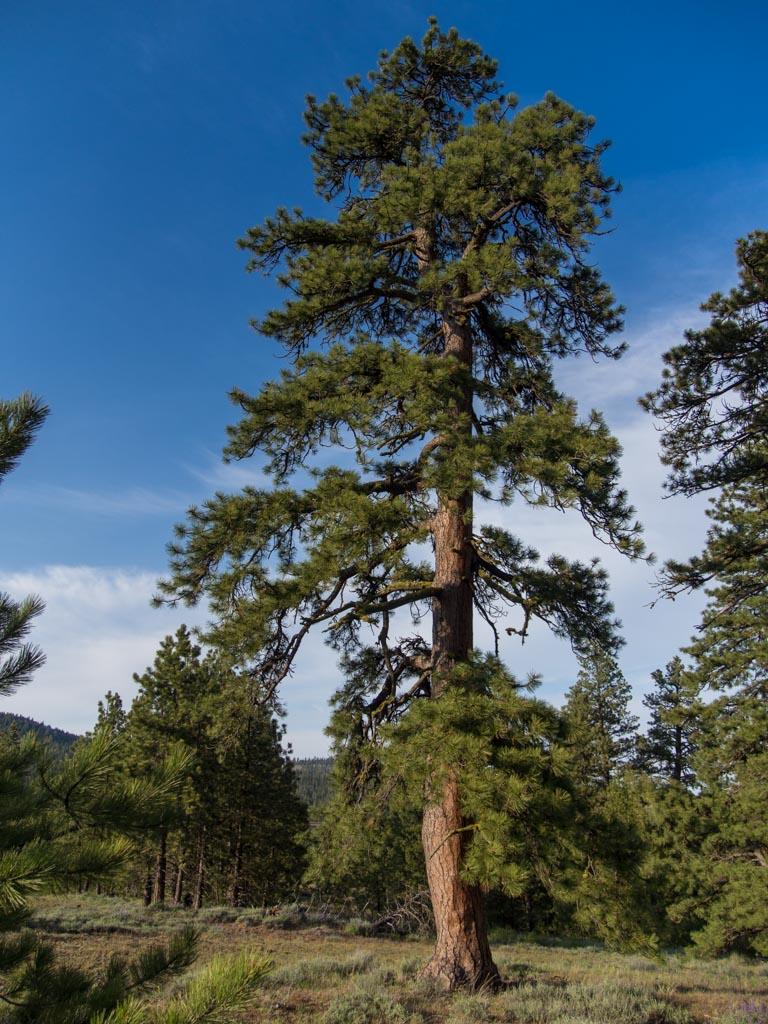
PINUS PONDEROSA
- Leaves & Flowers
Rugged-looking. Lean. Enduring. If a tree could personify the West, it would surely have to be the ponderosa pine. Writer Arthur Plotnik called it “a Clint Eastwood of a tree.” Montana has selected it as the state tree.
- Fruits:
This pine develops oval pine cones in a 3 cone cluster.
- Growth Habit & Hardiness
This Pine develops a deep taproot, making it wind-resistant. It has a medium growth rate with a mature height of 25' - 30'.
- Fall Color:
This tree displays dark gray-green to olive needles and cinnamon-colored bark that becomes fire-resistant once mature
- Wildlife Value:
The seeds provide food for birds and small mammals, particularly turkeys, nuthatches, crossbills, grosbeaks, pine siskins, grouse, squirrels, chipmunks and mice. The leaves, twigs and bark are browsed by porcupines, mule deer and elk. Snags (standing dead trees) provide a large number of wildlife species with nesting and roosting sites.
Rocky Mountain Juniper
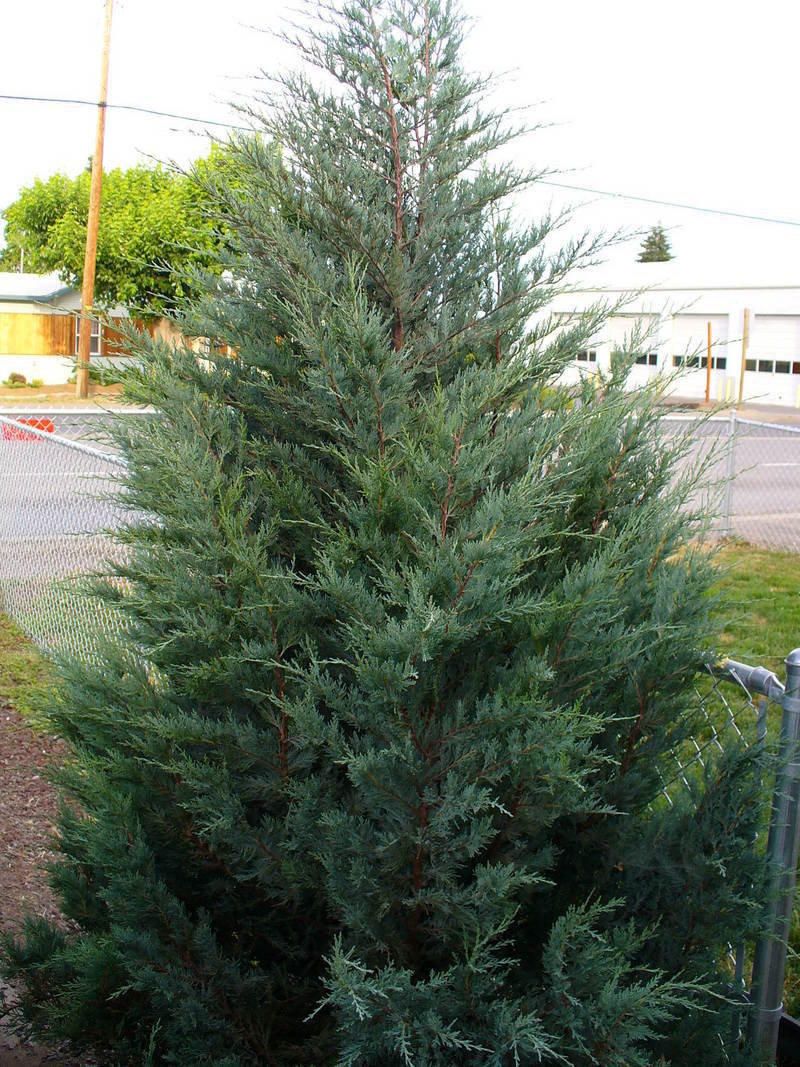
JUNIPERUS SCOPULORUM
- Leaves & Flowers
Rocky Mountain juniper is a medium sized, evergreen tree with a rounded to pyramidal-shaped crown and reddish-brown, fibrous bark. Rocky Mountain juniper's branches tend to be more upright and shed snow more easily (less snow breakage). It is found in the western Great Plains, through the Rocky Mountains and west into the Great Basin. In the Great Plains it is typically found on prairie hillsides.
- Fruits:
The fruit is eaten by many species of birds and other animals.
- Growth Habit & Hardiness
This is an excellent windbreak species which is often planted with or in place of Eastern redcedar. Use in both multiple and single row windbreaks. Rocky Mountain juniper is very similar to the Eastern Redcedar, but it is slower growing and smaller with a height of 20 to 30 feet and spread 8 to 12 feet. Rocky Mountain juniper is also less tolerant of shade and is much more susceptible to disease in humid areas.
- Fall Color:
Rocky Mountain juniper holds its summer deep green color throughout the year,
- Wildlife Value:
Rocky Mountain juniper is an important tree species for wildlife. The twigs and and leaves are browsed by deer and elk. Besides providing food, the branches of the Rocky Mountain juniper provide shelter and nesting sites for many bird species including juncos, sparrows, and robins. The branches form a dense cover that is popular with numerous wildlife species. The persistent fruit and dense foliage are especially valuable as emergency food and cover in severe winter storms.
Scotch Pine
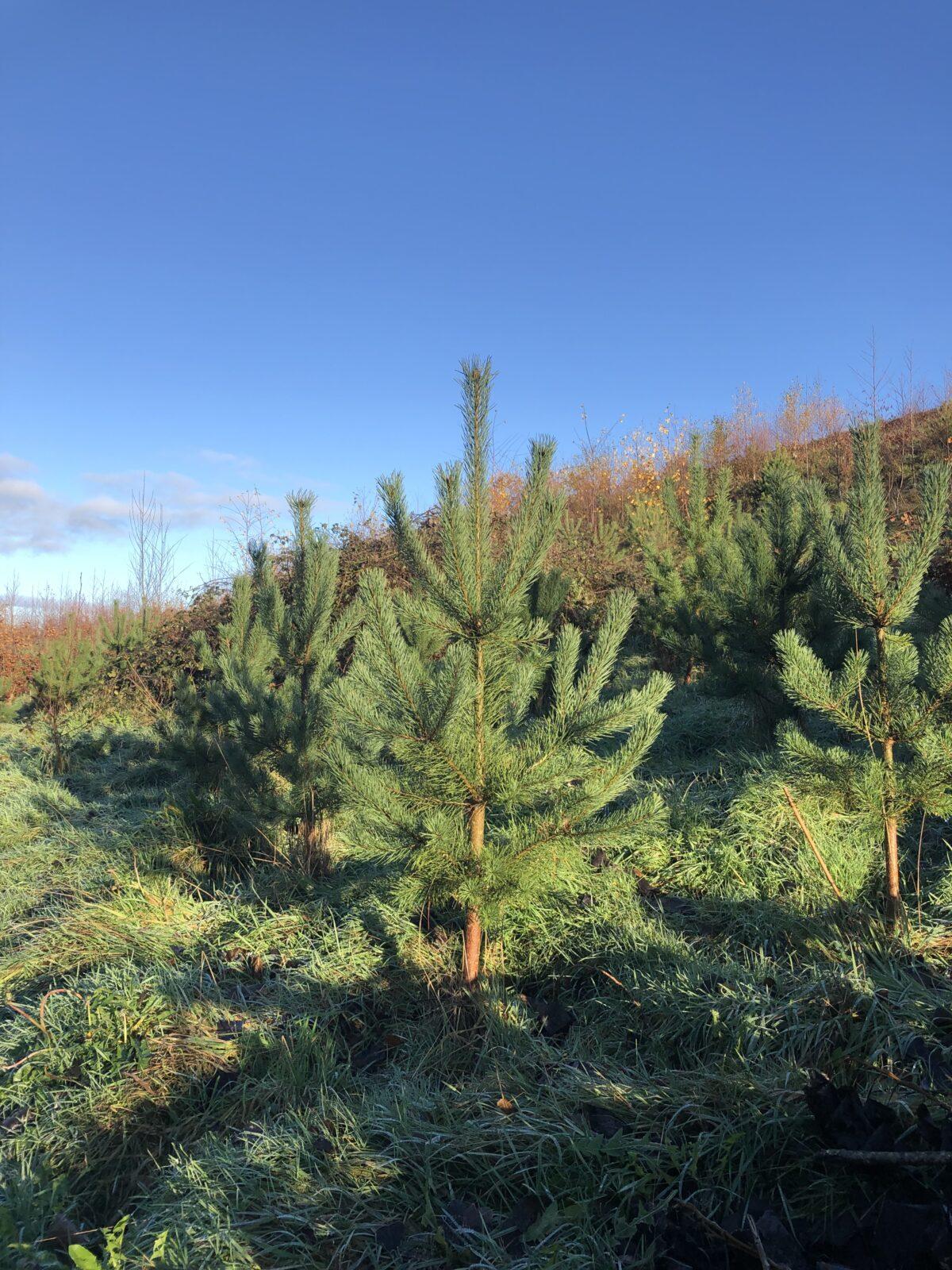
PINUS SYLVESTRIS
Also Known as Scots Pine
- Leaves & Flowers
The Scotch Pine features blue-green needles that vary in length, ranging from 1 to 3"; color frequently changes to yellowish-green in the winter. It grows in an oval, pyramidal shape.
- Fruits:
This tree produces oval, dry brown cones that are 1–3" in length.
- Growth Habit & Hardiness
The Scots pine is a beautiful evergreen that is hardy and adaptable to nearly all climates. It can be used as either a windbreak or a single specimen. This tree is also a popular Christmas tree choice because of its form and ability to hold onto its needles for an extended period of time. Because of its reseeding capabilities, the Scots pine is often used for reclamation sites. It prefers full sun and does most well drained soils.
Fall Color:
The Scotch Pine holds its summer deep green color throughout the year,
- Wildlife Value:
Owls prefer roosting and nesting in large conifers such as the Scots pine, and many mammals and birds consume pine seeds.
Siberian Larch
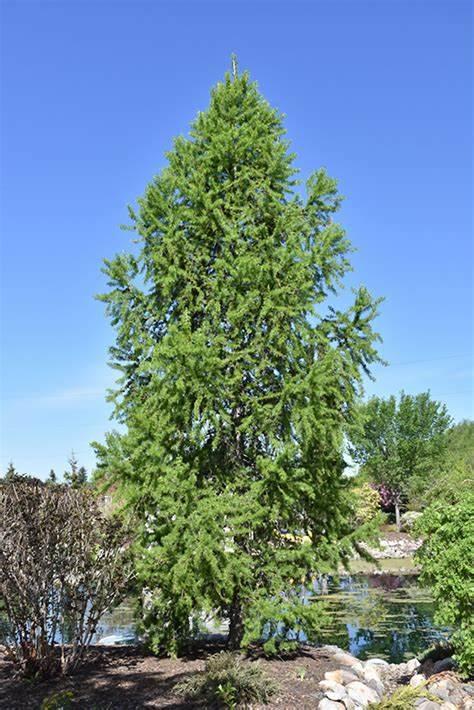
PINUS SYLVESTRIS
Also Known as Scots Pine
- Leaves & Flowers
The Scotch Pine features blue-green needles that vary in length, ranging from 1 to 3"; color frequently changes to yellowish-green in the winter. It grows in an oval, pyramidal shape.
- Fruits:
This tree produces oval, dry brown cones that are 1–3" in length.
- Growth Habit & Hardiness
The Scots pine is a beautiful evergreen that is hardy and adaptable to nearly all climates. It can be used as either a windbreak or a single specimen. This tree is also a popular Christmas tree choice because of its form and ability to hold onto its needles for an extended period of time. Because of its reseeding capabilities, the Scots pine is often used for reclamation sites. It prefers full sun and does most well drained soils.
Fall Color:
The Scotch Pine holds its summer deep green color throughout the year,
- Wildlife Value:
Owls prefer roosting and nesting in large conifers such as the Scots pine, and many mammals and birds consume pine seeds.
Swiss Stone Pine
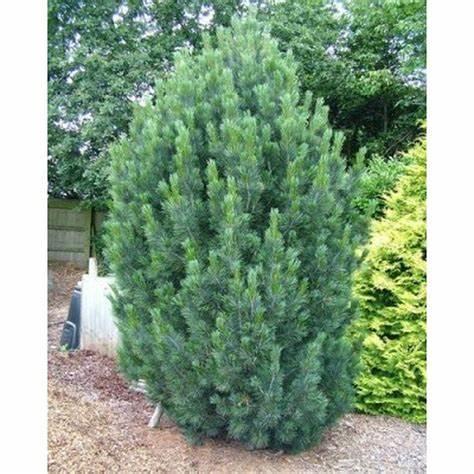
PINUS CEMBRA
Also known as Arolla Pine
- Leaves & Flowers
Soft, dark green to blue green needles (2-5” long) with white stomatic lines appear in bundles of five. Short-stalked, oblong cones (to 2.5” long) are greenish purple when young, maturing to purplish-brown. Cones never open.
Fruit
Cone seeds are edible. The pine nuts consumed as food in Europe primarily come from the stone pines.
- Growth Habit & Hardiness
It is native to mountain areas in central Europe from the Alps to the Carpathians. It is a slow-growing, medium-sized pine with a narrow pyramidal shape in its youth, gradually becoming rounded and more open as it matures. It typically grows 30-40’ tall in cultivation, but will grow to 100’ tall in the wild in its native habitat. It can be a good specimen pine for smaller landscapes. Easily grown in average, medium moisture, well-drained soils in full sun. Tolerates some light shade. Tolerates a wide range of soils, but prefers sandy loams. Appreciates sites with good air circulation. This pine prefers cool summer climates and is not recommended for planting south of USDA Zone 7.
Fall Color:
The needles are dark green to blue green in color all year round.
- Wildlife Value:
It is deer tolerant. is a valuable species for high-elevation ecosystems. It provides essential winter food and habitat for wildlife, including the spotted nutcracker, red squirrels, and voles, and offers protection in snowy climates. Its role in avalanche and erosion control, along with its resistance to white pine blister rust, also makes it valuable for afforestation and research